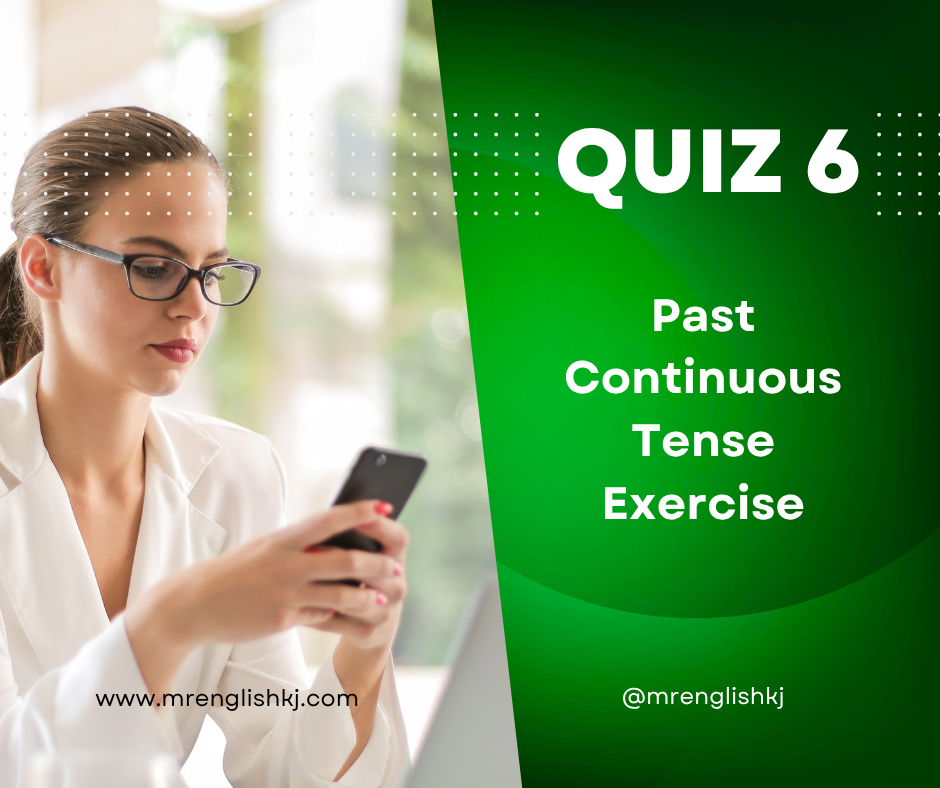
Past Continuous Tense — Exercise 6 (Q&A with Full Explanation and Vocabulary Builder, Learn English)
This practice test trains you to recognize and use the Past Continuous Tense (was/were + verb-ing) in real contexts. Each question includes the correct past-continuous form, a short verb definition (vocabulary builder + POS notes), and detailed one-sentence explanations for every option (A–D) that tell why the option is correct or incorrect and what choosing it would mean. Practice, prepare and improve both English grammar and vocabulary.
English Grammar Definition: Past Continuous (was/were + verb-ing)
- Form: was / were + present participle (-ing).
- Examples: I was writing; They were waiting; Was she sleeping?
- Main uses:
- Ongoing actions in the past (background actions).
- Actions that were in progress when another action interrupted.
- Parallel past actions (two things happening at the same time).
- Signal words: while, as, at 10 a.m., when, during.
- Negatives / Questions: was/were not (wasn’t/weren’t) + verb-ing; Was/Were + subject + verb-ing?
- To learn more about it – Visit Here
Quiz Instructions
- Read each question and choose the best answer out of four given options.
- On top, header section of the quiz, you will see the “title of the quiz,’ ‘spending-time,’ ‘value of question in points,’ and ‘number of questions.”
- Below on footer, you will see Full Screen mode. As the name suggests, it covers the whole screen. It will save a lot of your time attempting the quiz.
- You can zoom the images given in the questions.
- After submitting the quiz, you can see your score and compare with other users.
- The Full Leaderboard link will take you to a page, where you can see all users attempts.
- Below the quiz box, there are explanation of each options. You can study and try again.
- Best of Luck!
Quiz Question, Answer and Explanation
Note: Do remember in the quiz box above, the questions and options will shuffle, so they won’t have the same sequence like 1, 2, 3, or A, B, C as below.
1. While the lead engineer __ the new release notes, the team prepared the rollout.
A) was pondering B) pondered C) is pondering D) has pondered
Verb (POS & meaning): ponder — verb. To think carefully about something.
Correct: A) was pondering
A) Correct: Past continuous — thinking was in progress as the team prepared; choosing it shows an ongoing mental action.
B) Wrong: Past simple — would indicate the thinking finished, not that it was happening while preparation occurred.
C) Wrong: Present continuous — places the action in the present, not the past.
D) Wrong: Present perfect — implies present relevance rather than a past-in-progress event.
2. They __ the clocks to the same time while we tested synchronization.
A) were synchronizing B) synchronized C) are synchronizing D) have synchronized
Verb: synchronize — verb. To make things occur at the same time or rate.
Correct: A) were synchronizing
A) Correct: Past continuous — synchronization was in progress during testing; choosing it indicates simultaneous activity.
B) Wrong: Past simple — would state it was done, not in progress during testing.
C) Wrong: Present — wrong timeframe.
D) Wrong: Present perfect — implies effect now, not the simultaneous past action.
3. The operations manager __ the teams’ tasks while monitoring SLA compliance.
A) was orchestrating B) orchestrated C) is orchestrating D) has orchestrated
Verb: orchestrate — verb. To arrange or coordinate many parts to work together.
Correct: A) was orchestrating
A) Correct: Past continuous — coordination was ongoing as SLAs were monitored; choosing it highlights active direction.
B) Wrong: Past simple — suggests orchestration completed, losing the sense of background action.
C) Wrong: Present — not past.
D) Wrong: Present perfect — emphasizes result rather than ongoing past action.
4. The on-call engineer __ incoming incidents to priority queues when the spike began.
A) was triaging B) triaged C) is triaging D) has triaged
Verb: triage — verb. To quickly assess and prioritise problems for response.
Correct: A) was triaging
A) Correct: Past continuous — triage was in progress at the time of the spike; choosing it shows active prioritisation.
B) Wrong: Past simple — would present triage as a completed step rather than an ongoing process.
C) Wrong: Present — wrong timeframe.
D) Wrong: Present perfect — implies completed with present relevance.
5. They __ support tickets to regional teams while the outage persisted.
A) were dispatching B) dispatched C) are dispatching D) have dispatched
Verb: dispatch — verb. To send tasks, messages, or goods to a destination or person.
Correct: A) were dispatching
A) Correct: Past continuous — dispatch was ongoing during the outage; choosing it emphasises repeated/ongoing sends.
B) Wrong: Past simple — implies dispatch completed as a single action.
C) Wrong: Present — wrong tense.
D) Wrong: Present perfect — focuses on present state, not ongoing past activity.
6. The network admin __ traffic to the backup route when the primary link failed.
A) was routing B) routed C) is routing D) has routed
Verb: route — verb. To direct traffic or data along a path.
Correct: A) was routing
A) Correct: Past continuous — routing was happening as the failure occurred; choosing it shows real-time action.
B) Wrong: Past simple — suggests the routing finished before or after, not as an in-progress response.
C) Wrong: Present — wrong timeframe.
D) Wrong: Present perfect — implies current relevance rather than simultaneous reaction.
7. They __ the system’s performance against industry baselines during the test.
A) were benchmarking B) benchmarked C) are benchmarking D) have benchmarked
Verb: benchmark — verb. To measure performance and compare to standards.
Correct: A) were benchmarking
A) Correct: Past continuous — benchmarking was in progress during the test; choosing it signals measurement in real time.
B) Wrong: Past simple — would state a completed measurement.
C) Wrong: Present — wrong timeframe.
D) Wrong: Present perfect — indicates completed action with present result.
8. I __ latency figures while the developer pushed the patch.
A) was gauging B) gauged C) am gauging D) have gauged
Verb: gauge — verb. To measure or estimate a quantity or reaction.
Correct: A) was gauging
A) Correct: Past continuous — measurement was ongoing as the patch was applied; choosing it emphasises simultaneous monitoring.
B) Wrong: Past simple — would suggest the gauge finished.
C) Wrong: Present — wrong time.
D) Wrong: Present perfect — focuses on present effect.
9. The compliance officer __ log entries while the auditor reviewed records.
A) was scrubbing B) scrubbed C) is scrubbing D) has scrubbed
Verb: scrub — verb. To clean or sanitize data by removing inaccuracies.
Correct: A) was scrubbing
A) Correct: Past continuous — data cleaning was in progress as audit review occurred; choosing it shows background maintenance.
B) Wrong: Past simple — implies the cleaning was completed.
C) Wrong: Present — wrong timeframe.
D) Wrong: Present perfect — implies current relevance.
10. He __ suspicious records while reconciling the ledgers.
A) was reconciling B) reconciled C) is reconciling D) has reconciled
Verb: reconcile — verb. To bring two sets of records into agreement.
Correct: A) was reconciling
A) Correct: Past continuous — reconciliation was ongoing when suspicious items appeared; choosing it indicates process in progress.
B) Wrong: Past simple — would show completed reconciliation, not the activity in progress.
C) Wrong: Present — wrong timeframe.
D) Wrong: Present perfect — stresses present result.


